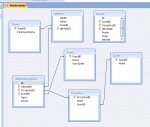Hi - I have bitten off a little more than I can chew; can't quite sort out how best to organize my data for a sports result tracking DB.
Basically, that looks something like this(I enter the data manually here and the sorting has to be done manually, too in Excel).
TEAM Athlete1 Athlete2 Athlete3 Athlete4 Athlete5 Total
TeamA Joe Smith Sam Hughes Tom Dick Dick Harry Harry Toms
5 2 1 8
So far, I have the following tables
Athletes
AthleteCode
Athlete Name
Teams (may also need normalizing since one team has five athletes)
Employee Name
Athlete Code
Points
Result (Ranking)
Points
Event
Discipline
Event Date
Sport
Sport
Discipline
Thorniest problems are:
I'm not sure how to deal with the multiple variables; one athlete competing in several events and getting several results.
I don't know how to get the DB to assign points based on ranking; if I figured that out, I may be able to figure out how to total points per team.
And, most of all, how to produce the report.
It's probably easy - I just haven't dealt with that many relationships at once before. Can you help?
- We have many employees
- Each employee has a 'team' of 5 athletes
- There are a number of sports. Each sport has a number of disciplines.
- Each athlete competes in one or more disciplines (in the same sport) and gets a ranking. Points are assigned according to ranking; specific rankings earn specific points (i.e. 1=5, 4-10 = 2)
- I want to design a form that will let me enter each athlete's ranking in each discipline as I get it (which will then generate the point score for the athlete)
- I want a report that shows (and is sorted by) total points earned by the entire team which also shows points per athlete per team.
Basically, that looks something like this(I enter the data manually here and the sorting has to be done manually, too in Excel).
TEAM Athlete1 Athlete2 Athlete3 Athlete4 Athlete5 Total
TeamA Joe Smith Sam Hughes Tom Dick Dick Harry Harry Toms
5 2 1 8
So far, I have the following tables
Athletes
AthleteCode
Athlete Name
Teams (may also need normalizing since one team has five athletes)
Employee Name
Athlete Code
Points
Result (Ranking)
Points
Event
Discipline
Event Date
Sport
Sport
Discipline
Thorniest problems are:
I'm not sure how to deal with the multiple variables; one athlete competing in several events and getting several results.
I don't know how to get the DB to assign points based on ranking; if I figured that out, I may be able to figure out how to total points per team.
And, most of all, how to produce the report.
It's probably easy - I just haven't dealt with that many relationships at once before. Can you help?

